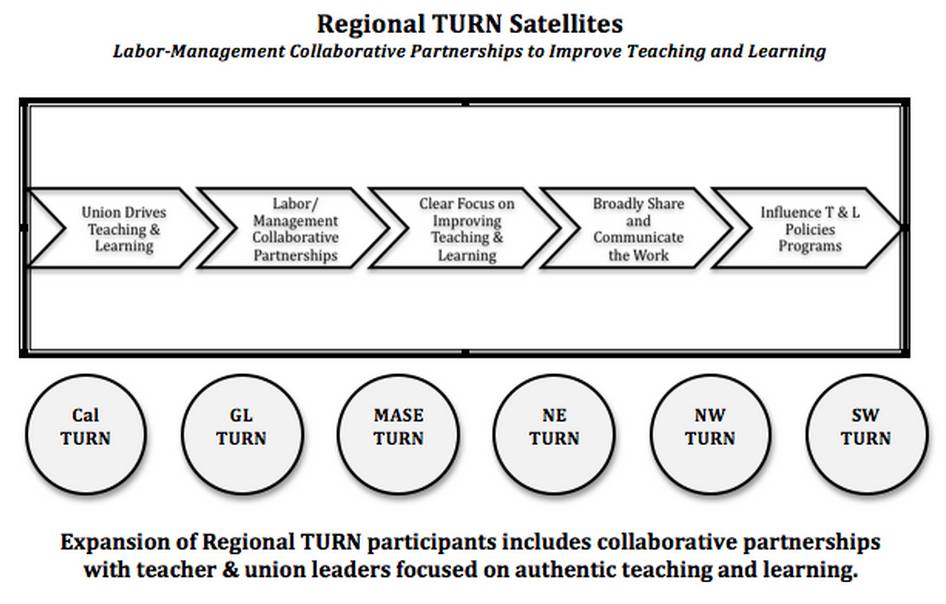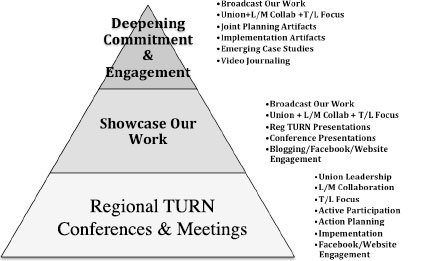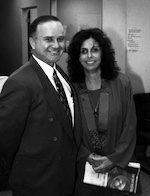Teacher unions must provide leadership for the collective voice of their members. Teacher unions have a responsibility to students, their families, and to the broader society. Teacher unions are committed to public education as a vital element of our democracy. What unites these responsibilities is our commitment to help all children learn. We affirm the union's responsibility to collaborate with other stakeholders in public education and to seek consistently higher levels of student achievement by:
- Improving continuously the quality of teaching.
- Promoting in public education and in the union democratic dynamics, fairness, and due process for all.
- Seeking to expand the scope of collective bargaining to include instructional and professional issues.
Improving on an ongoing basis the terms and conditions under which both adults and children work and learn.
Transforming Teacher Unions to Become Agents of Reform
Teacher Union Reform Network is a union-led effort to restructure the nation's teachers unions to promote reforms that will ultimately lead to better learning and higher achievement for all students. The primary goal of TURN is to create new union models that can take the lead in building and sustaining effective schools for all students. Because teachers are closest to students, to the learning process, and because of their link to parents and the larger communities, we are in a unique position to stimulate the necessary changes.
Standards for Responsible and Responsive Teacher Unions
Responsible and responsive teacher unions are committed to:
- consider students' learning as our primary goal and assume professional accountability for students' progress
- take responsibility for teaching quality, support teachers' professional learning and ensure that teachers are empowered at the school and classroom level
- improve the terms and conditions under which both adults and students work and learn
- expand the scope of collective bargaining to include instructional and professional issues and teacher involvement in educational decisions
- organize members by promoting quality and create ways for excellent practitioners to become leaders in our schools and in our unions
- collaborate with other stakeholders as equal partners and involve families and communities in students' learning
- protect the right of collective action and collective bargaining
- engage in democratic and transparent practices that are equitable and ethically and fiscally responsible
- honor dissent and promote social justice, self determination, fairness and due process
- preserve and improve public education maintain an open mind to new and promising ideas and changes
The Emerging Work of Our Regional TURN Satellites
The Teacher Union Reform Network (TURN), founded in 1995, is a nationwide network of more than 200 union locals from the American Federation of Teachers and the National Education Association. It brings local unions together to promote progressive reform in education and teacher unions, build relationships among key stakeholders and to cultivate the next generation of teacher leaders to influence education policymaking and improve teaching effectiveness and student learning. Our TURN regions are expanding these efforts across the nation, focusing on the following goals:
- Empower teacher unions to become leaders in driving improvements in teaching and learning
- Encourage labor/management collaboration to address policies, programs and practices that impact teaching and learning
- Encourage and support TURN regions and their participating teams to develop a teaching and learning focus
- Deepen commitment and engagement of labor-management collaborative teams to improve teaching and learning through Communities of Practice
- Create opportunities for TURN regions and their members to broadly share their successes and challenges
- Influence teaching and learning policies and programs at the local, state and national levels
The Consortium for Educational Change continues to support and deepen the current work of the regional TURN networks, which are developing Regional TURN Communities of Practice that will enable us to implement the following objectives:
- To identify and support a targeted and focused set of reform initiatives to improve teaching and learning that are planned and implemented collaboratively by labor-management teams in our TURN regions.
- To deepen the work of the TURN regions in developing and sustaining labor-management collaborative partnerships to improve teaching and learning
- To broadly share and communicate the results of our TURN regions and the state and local efforts to work collaboratively to develop and implement significant education reform policies and programs that impact student learning.
Local union-management collaborative teams that are participating in our TURN Regions are invited to partner with us as we establish Regional TURN Communities of Practice to support, showcase and share the work in ways where we learn from each other's efforts. We hope that together we can continue to explore and integrate the knowledge, skills and practices needed to strengthen labor-management collaborative partnerships to implement the common core standards, teacher evaluation and student growth measures in our schools and classrooms in ways that enhance professional practices and student learning.
We intend to create additional opportunities for our participating Regional TURN labor-management teams to learn from and share with other TURN members through:
- Deepening our commitment to work collaboratively to improve teaching and learning
- Developing and sharing our implementation plans for the CCSS, teacher evaluation systems and other education reform strategies
- Sharing our promising practices to implement the CCSS in our schools and classrooms
- Identifying and documenting emerging case studies focused on collaborative partnerships to implement the CCSS, teacher evaluation systems, student growth measures
- Exploring "union reform" efforts in ways that expands the role of teacher voice in education reform efforts, incorporates social justice for students and families and strengthens the quality of the teaching profession


Opportunities for Deepening Engagement and Support in our Regional TURN Communities of Practice
Local labor-management collaborative teams that agree to join our Regional TURN Communities of Practice will be provided the opportunity to participate in the following activities that are designed to support and deepen their collaborative efforts to plan and implement a targeted and focused set of reform initiatives to improve teaching and learning. Opportunities for engagement include:
- Participation in Regional TURN Conferences provides opportunities for our Regional TURN labor-management teams to listen and learn from each other's efforts to collaboratively plan and implement the College & Career Ready Standards, teacher evaluation and student growth measures.
- Gap Analysis Needs Assessment using materials and resources provided through the Regional TURN Conferences will assist labor-management teams in identifying strengths and opportunities for improvement related to collaborative efforts to implement the College & Career Ready Standards, teacher evaluation and student growth to improve teaching and learning. Our Regional TURN Coordinators, Virtual Community Organizers and CEC will work with the local team contact persons to track and monitor team progress through surveys and reports. This information will assist local teams in developing and aligning College & Career Ready Standards, curriculum and assessments, teacher evaluation and/or student growth implementation plans to guide their work. These team implementation plans will be shared with our Regional TURN Communities of Practice through our TURN website.
- The TURN Website provides a site to collect and share local and state labor-management collaborative policies, practices and protocols related to College & Career Ready Standards, Curriculum and Assessments, teacher evaluation and/or student growth implementation plans, professional development resources and other documents and resources to assist our Regional TURN teams as they tackle these issues in their at home.
- National Regional TURN Conferences. CEC will collaborate with our TURN Regions to convene an annual conference each summer – focused on labor-management collaboration, empowerment of teacher voice in leading out educational reform initiatives to improve teaching effectiveness and student learning.
- Emerging Case Studies. Our Regional TURN Coordinators, Virtual Community Organizers (VCOs) will work with CEC to capture local reform planning and implementation efforts through written and video journaling of emerging case studies that will be shared on the TURN website.
- On-The-Ground Supports for Targeted Regional TURN teams. CEC consultants will continue to seek ways to provide support, where possible, to key union-management collaborative teams in our TURN regions that are striving to work at high levels of collaborative engagement to significantly alter policies and programs that impact teaching and learning.
Communities of Practice Literature Review
Communities of Practice (CoP) can be defined, in part, as a process of social learning that occurs when people who have a common interest in a subject or area collaborate over an extended period of time, sharing ideas and strategies, determine solutions, and build innovations. Etienne Wenger gives a simple definition: “Communities of practice are groups of people who share a concern or a passion for something they do and learn how to do it better as they interact regularly.†Note that this allows for, but does not require intentionality. Learning can be, and often is, an incidental outcome that accompanies these social processes. One need to distinguish between what is a CoP and what is not. There are three required components of CoPs:
- There needs to be a domain. A CoP has an identity defined by a shared domain of interest (e.g. radiologists, Star Trek fans, middle school history teachers, Seahawks football fans, etc.); it's not just a network of people or club of friends. Membership implies a commitment to the domain.
- There needs to be a community. A necessary component is that members of a specific domain interact and engage in shared activities, help each other, and share information with each other. They build relationships that enable them to learn from each other. In this way, merely sharing the same job does not necessitate a CoP. A static website on hunting in itself is not a community of practice. There needs to be people who interact and learn together in order for a CoP to be formed. Note that members do not necessarily work together daily, however. Wenger points to the example of Impressionist painters who sometimes met in cafes to discuss their painting styles. He indicates that even though these men normally painted alone, these kinds of interactions were essential to naming them a CoP.
- There needs to be a practice: A CoP is not just people who have an interest in something (e.g. sports or agriculture practices. The third requirement for a CoP is that the members are practitioners. They develop a shared repertoire of resources, which can include stories, helpful tools, experiences, stories, ways of handling typical problems, etc. This kin of interaction needs to be developed over time. A conversation with a random stranger who happens to be an expert on a subject matter that interests you does not in itself make a CoP. Informal conversations held by people of the same profession (e.g. office assistants or graduate students) help people share and develop a set of cases and stories that can become a share repertoire for their practice, whether they realize it or not.
Communities develop their practice through a variety of methods, including problem solving, requests for information, seeking the experiences of others, reusing assets, coordination and synergy, discussing developments, visiting other members, mapping knowledge and identifying gaps.
Etienne Wenger
http://wenger-trayner.com/theory/
History of TURN

From the very beginning, TURN's purpose has been to challenge teacher union leaders to take steps to promote teachers as professionals, advance a broad based new unionism, and link professionalism and new unionism to ways for improving student learning.
TURN is a union-led effort to restructure teachers unions to help promote the kinds of reforms that will lead to better learning and higher achievement for all students (see, Proposal to Pew Charitable Trusts).
TURN's intended goal is to explore, develop, and demonstrate models that lead to the restructuring of unions so that they will become more responsive and responsible in organizing around projects designed to improve student learning.
In July 1995, Adam Urbanski, President of the Rochester Teachers Association, and the late Helen Bernstein, former President of the United Teachers of Los Angeles, CA., both local union leaders at the time, convened a group of progressive teacher union leaders from 21 urban union locals to discuss how educational reform has evolved at the local level. The group discussed how educational reforms and massive cuts in financing were undermining public education. They recognized that many school districts were trying to reform their schools, but rarely were the teacher unions included. This conversation led to the creation of the Teacher Union Reform Network (TURN) in 1996.




